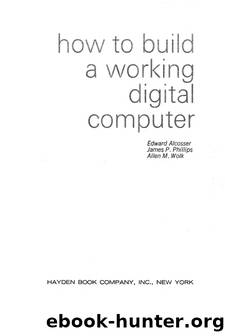How to Build a Working Digital Computer by Unknown

Author:Unknown
Language: eng
Format: epub
Tags: core, computer, rin, binary, lamp, switch, ace, digital, program, decimal, digital computer, working digital, machine screws, lamp lights, arithmetic unit, composition board, core memory, partial product, computer table, wood screws
Published: 1968-08-15T00:00:00+00:00
2«
i 23o
1 22o i 2'o
1 2%
2-1 2-2 2-3 2-4
q:
SIGN
s
e ra
H
SI B S Si
1 EXTENSION REGISTER *
n
□ □
l-.l
n
i
1 FUNCTION SELECTOR '
H
H 1X1
H
Sll
Aoop] nnn
subc 1 LJ LJ L_i
1—AOO/SUB SWITCH >
n
□ n
n
i
□ □
X-REG1STER
i
DISPLAY
Fig. E-9.
9. 10.
11.
12.
set to 0 and remains lighted when switching the next switch. Note that
after switch 2° is set, all lamps are extinguished.
Set the Add/Sub switch to Add.
In order, set the 2°, 21, 22, and 23 switches of the X-Register to 1.
Note that the lamp corresponding to each switch is lighted.
In order, set the 2°, 21, 22, and 23 switches of the Accumulator to 1.
Note that after 2° is set, only the 2* lamp is lighted. After 21 is set, the
21 and 24 lamps are lighted. After 22 is set, the 21, 22, and 24 lamps are lighted. After 23 is set, all lamps are lighted except 21.
In order, set the 23, 22, 21, and 2° switches of the X-Register to 0. Note that after 23 is set, the 24, 22, and 21 lamps are lighted. After
22 is set, the 2* and 21 lamps are lighted. After 21 is set, only the 24 lamp is lighted. After 2° is set, all lamps are lighted except 24.
Chapter 5 STORAGE DEVICES
One of the reasons why computers are called "electronic brains" is their ability to store and "remember" instructions and data. Because it has a memory, the computer is released from the common calculating machine's dependence on human, external, step-by-step control. Once it has received its instructions and the proper data, the computer can work without interruption and take advantage of the high computational speeds that have made it such an invaluable tool.
Memory units take several forms, according to their function, and are found in all parts of the computer. Some are used continuously and others are referred to only at specific moments during a calculation. Because they receive and hold information, these memory units are also called storage devices. A computer's computational ability is related directly to the amount of information it can store, its storage capacity, and the speed with which it can obtain information from these storage devices.
There are four types of storage employed in present-day computers: the register store, the internal memory, the auxiliary internal memory, and the external memory. The frequency of use of these units is dependent on the ease with which data can be recovered from them.
Register stores are used continuously during computer operation. Partial answers, digits being operated on, and actual calculations are registered in these devices. Essentially, they are two-position switches that store 1 in one position and 0 in the other. The double-throw switches used in our arithmetic unit represent this type of storage device. Because information passes quickly through them they are considered to be short-term storage units.
The internal memory is the major storehouse in the computer. It holds all of the information supplied by the programmer: both the instructions to be followed, in sequence, and the data to be used. The auxiliary memory store, also internal, is used to back up the
Download
This site does not store any files on its server. We only index and link to content provided by other sites. Please contact the content providers to delete copyright contents if any and email us, we'll remove relevant links or contents immediately.
| Automotive | Engineering |
| Transportation |
Whiskies Galore by Ian Buxton(41882)
Introduction to Aircraft Design (Cambridge Aerospace Series) by John P. Fielding(33064)
Small Unmanned Fixed-wing Aircraft Design by Andrew J. Keane Andras Sobester James P. Scanlan & András Sóbester & James P. Scanlan(32744)
Craft Beer for the Homebrewer by Michael Agnew(18144)
Turbulence by E. J. Noyes(7940)
The Complete Stick Figure Physics Tutorials by Allen Sarah(7310)
Kaplan MCAT General Chemistry Review by Kaplan(6867)
The Thirst by Nesbo Jo(6829)
Bad Blood by John Carreyrou(6554)
Modelling of Convective Heat and Mass Transfer in Rotating Flows by Igor V. Shevchuk(6391)
Learning SQL by Alan Beaulieu(6212)
Weapons of Math Destruction by Cathy O'Neil(6148)
Man-made Catastrophes and Risk Information Concealment by Dmitry Chernov & Didier Sornette(5924)
Digital Minimalism by Cal Newport;(5665)
Life 3.0: Being Human in the Age of Artificial Intelligence by Tegmark Max(5476)
iGen by Jean M. Twenge(5367)
Secrets of Antigravity Propulsion: Tesla, UFOs, and Classified Aerospace Technology by Ph.D. Paul A. Laviolette(5309)
Design of Trajectory Optimization Approach for Space Maneuver Vehicle Skip Entry Problems by Runqi Chai & Al Savvaris & Antonios Tsourdos & Senchun Chai(5011)
Pale Blue Dot by Carl Sagan(4913)
